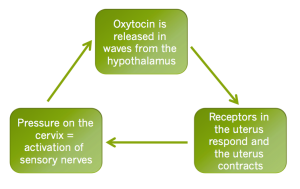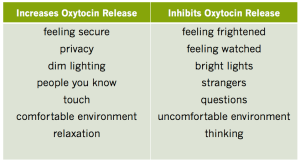Sangat kagum, sebenarnya kontraksi dikawal oleh hormon.
The hormonal formula is: oxytocin (love) + beta-endorphin (dependency) + prolactin (mothering) = mother-baby-bond.
Badan kita bekerja bergantung kepada love, dependency dan prolactin. Owh rupanya mudah jer. Tiadala urat saraf vena ke sel darah ke apa...
Kalau rajin boleh baca ni : http://midwifethinking.com/2010/08/18/the-effective-labour-contraction/
How a contraction works (overview)
Physical component:
 The hormone oxytocin regulates contractions and it is released from the hypothalamus (primitive brain). The uterus has oxytocin receptors which respond to oxytocin by initiating a contraction. Contractions start in the top of the uterus and ‘wave’ downwards. The cervix must be ready (ie. ripe) before it will respond to contractions by opening. This is why induction usually involves preparation of the cervix with prostaglandins before starting a syntocinon (pitocin) drip to create contractions. When the uterus contracts the placental circulation is reduced (more so if the waters have broken), slightly decreasing the oxygen supply to the baby. This is why there are breaks in between contractions – to allow babies to rebalance their oxygen levels before the next contraction. If you’re wanting a reference for the above, any midwifery A&P text book will cover this basic physiology eg. Coad 2005, Stables & Rankin 2010.
The hormone oxytocin regulates contractions and it is released from the hypothalamus (primitive brain). The uterus has oxytocin receptors which respond to oxytocin by initiating a contraction. Contractions start in the top of the uterus and ‘wave’ downwards. The cervix must be ready (ie. ripe) before it will respond to contractions by opening. This is why induction usually involves preparation of the cervix with prostaglandins before starting a syntocinon (pitocin) drip to create contractions. When the uterus contracts the placental circulation is reduced (more so if the waters have broken), slightly decreasing the oxygen supply to the baby. This is why there are breaks in between contractions – to allow babies to rebalance their oxygen levels before the next contraction. If you’re wanting a reference for the above, any midwifery A&P text book will cover this basic physiology eg. Coad 2005, Stables & Rankin 2010.
Note: Oxytocin (syntocinon/pitocin) administered via a drip is not released in waves and an individual woman’s oxytocin receptor response is unpredictable. This may result in contractions that are too powerful without an adequate gap between them leading to a hypoxic baby – similar to what happens during directed pushing.
The psychological / emotional component:
Oxytocin is influenced by, and influences feelings and behaviour. There is a growing body of research exploring this aspect of oxytocin and it’s potential uses from treating autism to persuading us to buy products in shops. For real oxytocin nerds like myself, Moberg has written an entire book on how this hormone works. Michel Odent and Sarah Buckley are gurus when it comes to the function of oxytocin in birth, mothering and breastfeeding and I would recommend anything written by them. Basically oxytocin is part of the hormonal cocktail that prepares a mother and baby for bonding and attachment. The hormonal formula is: oxytocin (love) + beta-endorphin (dependency) + prolactin (mothering) = mother-baby-bond.
Note: Oxytocin does not cross the blood brain barrier. Therefore, only oxytocin produced in the brain has these psychological/emotional effects. Syntocinon/pitocin administered via a drip into the blood stream only effects the uterus ie. contractions.Contraction pattern
Contractions are measured according to how often they occur in a 10 minute period and are recorded as 2:10, 3:10, 4:10 etc. To be considered ‘effective’ contractions need to occur 3:10 or more and last for 45 seconds or more. From a mechanistic perspective it would be impossible to progress through labour with 2 contractions or less every 10mins. I actually believed this for a some time (again sorry to those women).
What I now know is that a woman’s contraction pattern is unique. I have witnessed women birth babies perfectly well with very ‘ineffective’ contraction patterns. The recent ones that stand out in my mind are: A woman with an OP baby whose contractions never got closer than 5 minutes apart and were mostly 7-10 minutes apart. And a first time mother who birth her baby with mostly 10 minute spaces between contractions. When left to birth physiologically women’s labour patterns are as unique as they are. Unfortunately many midwives are unable to witness a variety of contraction patterns because individuality is not tolerated in the hospital setting.

No comments:
Post a Comment